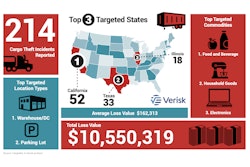

As of late last week some of the most recent results point to a 23-page report from the federal Bureau of Labor Statistics (BLS) titled Is the U.S. Labor Market for Truck Drivers Broken? That same search leads to coverage of and responses to that report.
In short, the BLS report says there is not so much an industry-wide lack of truck drivers, but rather that long-haul, truckload fleets have a problem retaining the drivers they do hire. The report, which covers data from 20103 to 2017, also suggests most driver recruitment and retention issues could be solved by improving driver pay, something that occurred with some frequency in 2018.
Written by Stephen Burks, an economics professor at the University of Minnesota Morris and Kristen Monaco, an associate commissioner in the Office of Compensation and Working Conditions at the BLS, the report suggests the perception of a shortage has been created by media — including and especially the trucking industry trade press — repeating driver shortage assertions of the industry’s leading trade organization, the American Trucking Associations.Not surprisingly, the ATA dismisses the BLS report. Conversely, the Owner-Operators Independent Drivers Association sees the report as supporting its long-held contention that no shortage exists. The association goes so far as to say the shortage is just a myth. And, the Truckload Carriers Association suggests several other issues are undercutting the ability of trucking companies to realize the full potential productivity of the drivers they already employ.
What the ATA Says
Bob Costello, the ATA’s Chief Economist, said the authors of the BLS report don’t understand the trucking industry or how his organization views the issue and that some of the data they used is out of date.
“This work ignores ATA’s long-standing contention that at the heart of the shortage is the need for qualified drivers,” said Costello. “Unlike other ‘blue collar’ jobs the authors compare truck drivers to – motor carriers cannot simply hire anyone to do the job, there are many barriers to entry for new drivers: age requirements, CDL testing standards, strict drug, and alcohol testing regimes and, perhaps most importantly for many fleets safe and clean driving records.
“Carriers repeatedly say it isn’t that they don’t have enough applicants for their open positions – they do. What they do not have is enough applicants who meet the demanding qualifications to be hired. In some cases, carriers must reject 90% of applicants out of hand because they fail to meet at least one of the prerequisites to drive in interstate commerce.”
Costello adds the authors don’t understand that driving a truck is not the same as holding other “blue collar” jobs.
“Unlike their blue-collar brethren, truck drivers are often away from home for long stretches as part of the job,” said Costello. “Not adjusting their conclusions for something as important as work-life balance leads the authors to make some ill-found claims.”
What OOIDA Says
“We have often said that the notion of a driver shortage is a myth,” said Todd Spencer, OOIDA president. “Our greatest concern about the perpetuation of the myth is that the misinformation is used to push agendas that are harmful to the industry and highway safety.”
In a statement about the BLS study, OOIDA said it disagrees with the proposal of lowering the age for driving interstate from 21 to 18.
“If safety is the top priority when considering a change to a regulation, when it comes to age, the number should be raised, not lowered,” said Spencer.
OOIDA also said it believes the problem of retaining drivers is of trucking companies own doing.
“Most carriers with high turnover do so by design,” said Spencer. “They could deal with driver turnover by offering better wages and benefits and improved working conditions. But putting younger drivers behind the wheel of a truck isn’t the solution because it does nothing to address the underlying issues that push drivers out of the industry. It merely exacerbates the churn.”
What the TCA Says
Dave Heller, vice president of government affairs at TCA, said shortage or not, there are numerous issues that are eroding the productivity of existing drivers, sometimes by as much as half.
“Regardless of whether people choose to support the notion of a driver shortage or the new market-driven philosophy recently made available by BLS, TCA members always have and will continue to make sounds decisions based upon the needs of their own fleets’” said Heller in a statement. “That being said, driver shortage or not, the real conversation must center around industry data that points to current driver disruptions such as detention, infrastructure problems and the availability of adequate truck parking that had led to this industry achieving overall driver utilization numbers somewhere between 5.5 and 6.5 hours per day. In other words, we are leaving approximately four to five hours of an eleven-hour drive time unused, and our industry must focus on driving the narrative that affects change to those numbers.
“Imagine an industry where our drivers can perform the job that they were actually hired to do, which is drive. Engaging in conversations with customers, manufacturers and our government representatives, at both DOT and in Congress, on sensible revisions to hours of service and a new infrastructure plan will go a long way toward making the driving job more attractive than it is now by reducing detention, alleviating congestion and making the most out of a driver’s day.”











